When someone asks, ‘how long does it take to learn to surf?’ the answer is typically between a few hours and a month. This isn’t just idle curiosity – it’s the first wave you’ll catch on your new adventure. Whether you’re gearing up for your first lesson or aiming to upgrade your skills, this article will lay down the timeline you can expect. So, let’s dive into the world of surfing and discover how long it might take you to ride the waves with confidence and style.
How Fast Can You Learn to Surf?
The time to become a proficient surfer can vary greatly, with some mastering the basics in just a few hours, while others may take up to a month, depending on several factors.
In your early surfing lessons, you’ll start by learning how to lie on the surfboard and maintain balance. It can take a short while, ranging from 30 minutes to a few hours, depending on how quickly you grasp it. After you’ve got the move, you will learn how to paddle and catch waves, which may require additional hours of practice and is heavily influenced by your physical fitness.
The pop-up, where you transition from lying to standing on the board, is often the most challenging part for new surfers. You should expect to fall often and find it tough to deal with the waves initially. But once you master this technique, much like riding a bike, it becomes a skill that stays for a lifetime.
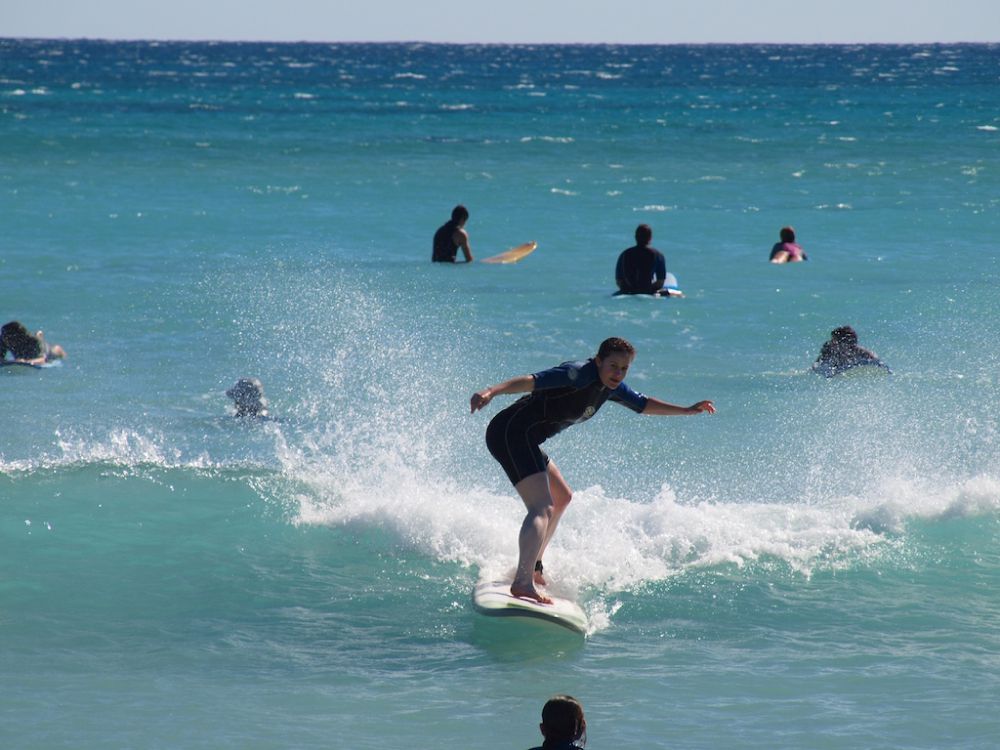
Surfing multiple times a week can lead to quicker progress compared to just surfing on weekends.
Your commitment, physical fitness, and affinity for water sports play significant roles in how quickly you pick up surfing. Age isn’t a significant factor; a fit 60-year-old might learn faster than a less active 16-year-old.
On average, with a suitable surfboard and dedication, you can expect to ride a wave after 5 to 20 hours of practice. The key is persistence, patience, and motivation. The more you surf and observe others, the quicker you’ll improve.
As a beginner surfer, one of the first obstacles you’ll face is learning the proper way to stand on your board. Surfing isn’t only about physical skills; it’s also about understanding the sea. How quickly you improve depends on the types of waves you surf, your swimming ability, your ocean knowledge, and having the right equipment.
Ready to conquer the waves and feel the thrill of surfing? Dive into our guide for essential surfing tips for beginners. Discover how to master the basics, from standing up on your board to reading the ocean’s rhythm.
How Many Surf Lessons Do You Need?
Diving into the world of surfing, you’re probably wondering about the number of lessons it takes to get up on a surfboard and catch those waves like a pro. Well, it really depends on your fitness level, as everyone’s path in surfing is unique. Let’s simplify it with a table that gives you a good idea based on where you stand in terms of fitness:
| Fitness Level | Getting Up on the Board | Riding Waves Confidently |
|---|---|---|
| Less Active | 3 to 4 Classes | 6 to 8 Classes |
| Average Fitness | 2 Classes | 3 to 4 Classes |
| Good Shape | 1 Class | 2 to 3 Classes |
| Top Fitness | 1 Class | 2 Classes |
Assuming each class is about 2 hours, you’re learning in a small group (3-5 people).
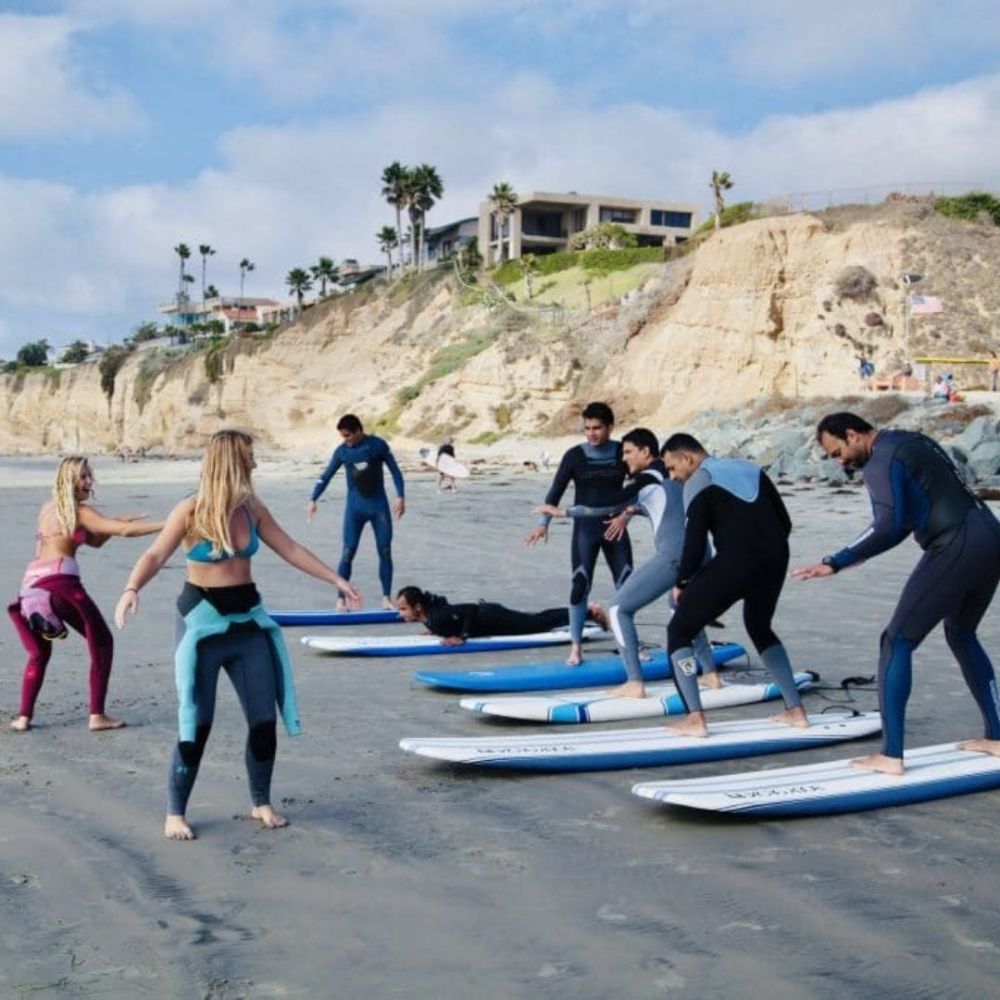
What to Keep in Mind for Surf Lessons
- Who’s Teaching You: A big part of how fast you learn is who’s teaching you. Make sure your instructor knows their skills – it makes a huge difference.
- Class Size: Smaller classes mean you get more attention and customized tips, which can speed up your learning.
- What You’re Using: It’s a good move to pick a surf school that lends out boards and wetsuits. That way, you get to try before you buy and learn with the right gear.
You will pick the best surf school and set realistic expectations based on your fitness when applying these tips. Get these right, and you’ll be cruising those waves in no time!
The Surfing Learning Curve
How long does it take to learn to surf well depends largely on your dedication and practice frequency. Here’s a look at the typical stages and timelines in the surfing learning curve for a complete novice aiming to become an intermediate surfer:
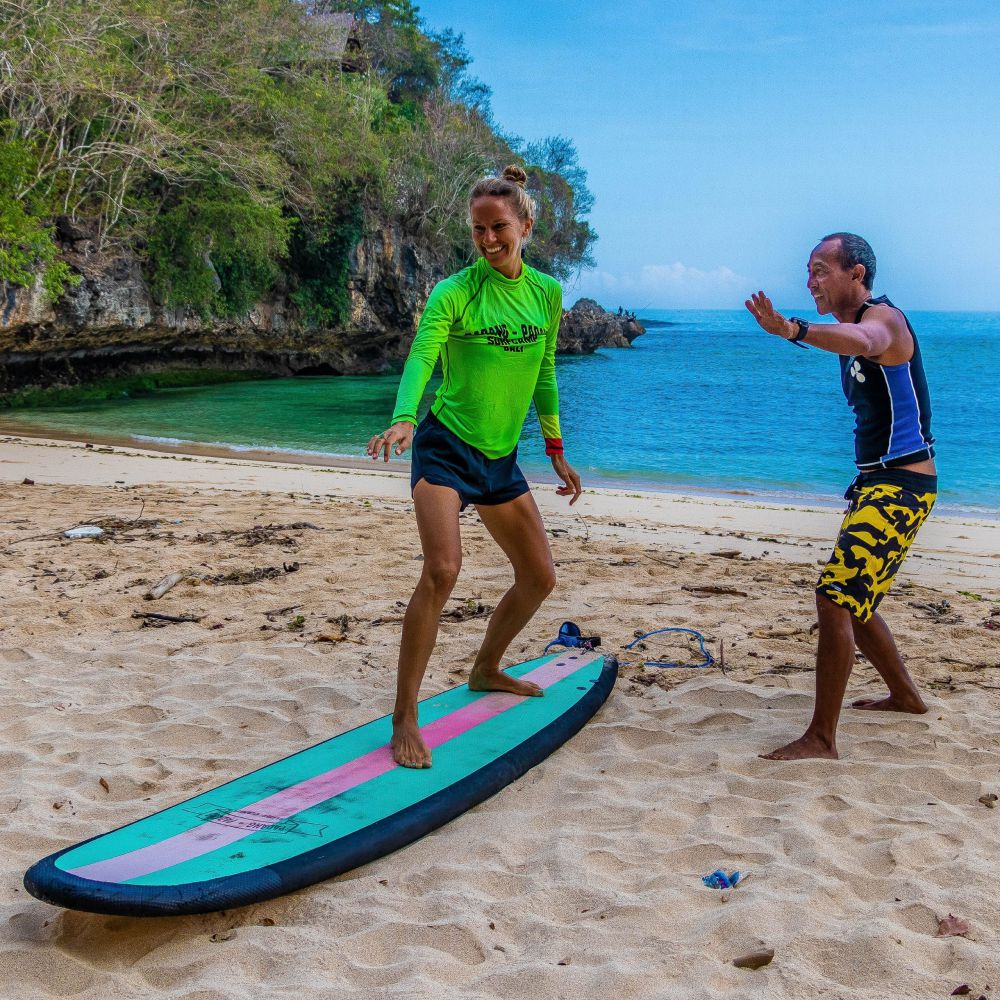
Initial Stage (2-4 Weeks)
- Focus: Get comfortable in the ocean.
-
Skills to Develop:
- Enhance freestyle swimming to be strong and relaxed.
- Learn safe wipeout handling techniques.
- Practice proper duck diving for paddling past breaking waves.
- Build endurance for paddling.
Catching Unbroken Green Waves (1-3 Weeks)
- Focus: Begin to interact with unbroken waves.
-
Skills to Develop:
- Identify suitable beginner surf zones.
- Time your paddling to match the wave’s speed.
- Practice the pop-up to a bent knee stance.
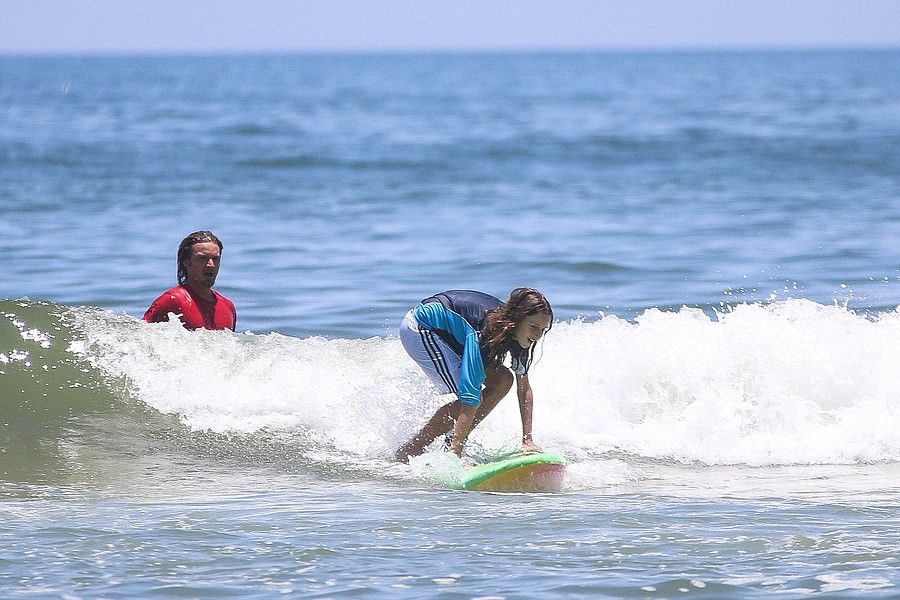
Riding Broken Whitewash (2-6 Weeks)
- Focus: Catch and ride simpler waves.
-
Skills to Develop:
- Ride mushy, crumbled waves towards the shore.
- Learn to control speed by angling the board.
- Achieve stability in standing up through the ride.
Riding Green Unbroken Waves (6 Weeks to 5 Months)
- Focus: Tackle more challenging waves.
-
Skills to Develop:
- Determine the best takeoff points based on the wave curl.
- Match your board’s speed with the unbroken swell while paddling.
- Master a quick pop-up to your feet before the wave breaks.
Developing Style (6 Months to 2 Years)
- Focus: Refine and personalize your surfing style.
-
Skills to Develop:
- Improve balance for trimming and maneuvering on the wave.
- Perfect a smooth transition to standing from the pop-up.
- Learn advanced techniques like carving, nose riding, and cutbacks.
For a complete beginner, progressing to an intermediate level typically takes about 6 months to 1 year with regular practice. However, truly mastering surfing is an ongoing journey that spans years, constantly evolving with experience and practice.
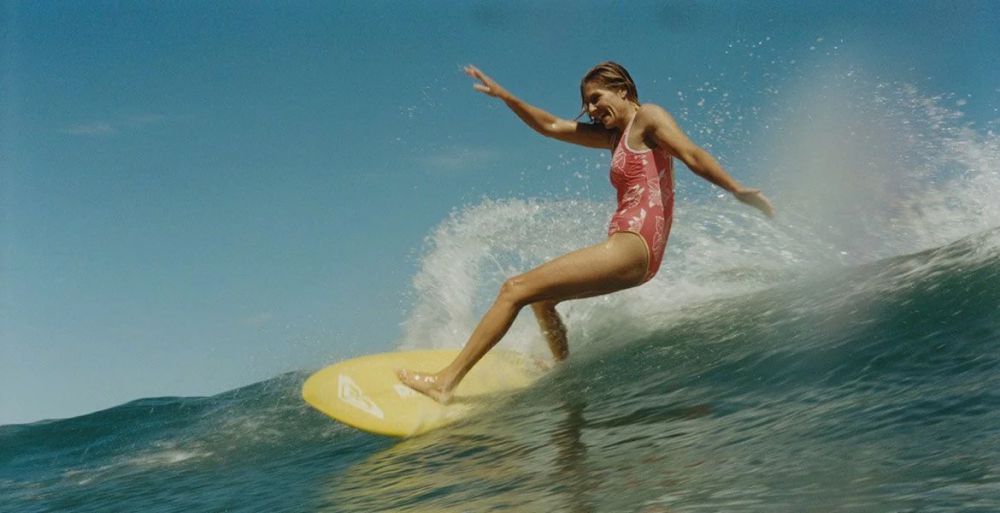
Factors Influencing the Learning Curve
As you begin your surfing journey and wondering how to get better at surfing for beginners, it’s time to recognize the various factors that can impact your learning curve.
- Physical Fitness: Your overall fitness level significantly impacts your ability to learn surfing
- Consistency in Practice: The more time you spend in the water practicing, the quicker you’ll improve. Consistency helps in building muscle memory and refining your technique.
- Quality of Instruction: Having a knowledgeable and experienced instructor so they can provide personalized feedback and correct your mistakes in real-time.
- Surf Conditions: The type of waves you practice on matters. Beginners often progress faster in smaller, more manageable waves where they can safely practice the basics.
- Equipment Used: Beginners should start with larger, more stable boards that make balancing and catching waves easier.
- Mental Attitude: A positive and resilient attitude helps in overcoming challenges and frustrations that come with learning something new.
- Learning Environment: A supportive and encouraging learning environment can enhance your progress. Surfing with friends or in a community can provide motivation and helpful tips.
- Adaptability and Learning Style: Everyone has a different learning style. Being adaptable and open to trying different techniques can help you find what works best for you.
- Age and Flexibility: While surfing can be learned at any age, younger surfers may learn quickly due to natural agility, but older surfers often bring valuable patience to the learning process.
The journey to becoming skilled in surfing is as rewarding as it is challenging, and embracing each step is part of the adventure.
Looking to improve your surfing skills? Check out best surfing exercises aimed at enhancing your strength and balance for surfing
How to Improve Surfing Faster?
Improving your surfing skills and reducing the time it takes to surf well involves more than just frequent practice. Incorporating specific training tips can significantly speed up your progress. Here’s a list of strategies to enhance your surfing skills:
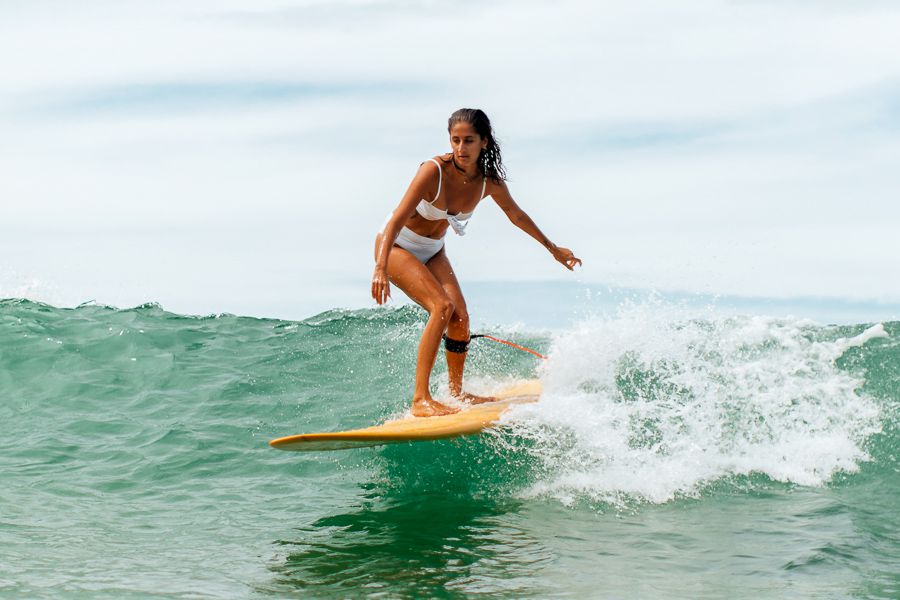
- Film Yourself Surfing: A great way to see what you’re doing right or wrong is to have someone video your sessions. Later, you can watch and pinpoint areas for improvement.
- Stretch First: Loosen up with some stretches before hitting the waves.
- Start with Gentle Waves: Practice your pop-up on softer waves. It’s a chill way to get the hang of it without too much pressure.
- Visualize Your Success: Picture yourself catching and riding waves in your mind.
- Gradually Level Up Your Moves: Start with mastering your paddle out, then slowly add in more complex maneuvers as you get comfortable.
- Work on Your Wave Timing: Spend the first part of your surf session paddling alongside unbroken waves. It’s a solid way to get better at reading waves and nailing your timing.
- Use Your Core: Engage those core muscles while paddling. It’s about arm strength; your core power can really boost your speed.
- Safety Skills: Make sure you’re up to speed on surf safety, like how to use your leash correctly, which can save you from trouble.
- Watch and Learn: Pay attention to other surfers, especially the pros. You can learn a lot just by observing their moves and techniques.
- Be Smart with Your Training: Plan out your practice sessions with a focus. Working on one skill at a time can lead to better and quicker mastery.
If you want to take your surfing to the next level, you must try the Boost Fin, a revolutionary device that can help you catch more waves and improve faster. Also, setting it up is super easy – you can attach it to any board in just about 5 minutes. With the Boost Fin, you’ll be using less energy and stamina, which means you can catch a higher number of waves in less time.
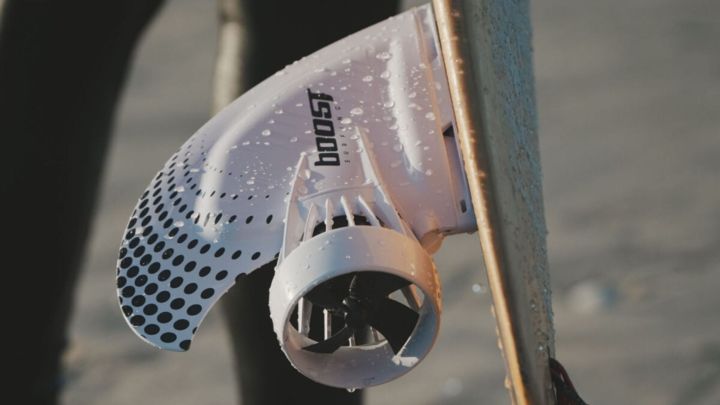
- Quick and Easy Setup: Fits any longboard, shortboard, or paddleboard board in just 5 minutes. You get to stick with your favorite board and still enjoy the Boost Fin’s perks.
- Catch more waves: You can improve your wave selection and positioning and ride waves that you normally couldn’t with speeds of 10 mph, turning wave-catching into an exhilarating experience.
- Surf longer: Say goodbye to those all-too-short surfing sessions. With the Boost Fin’s impressive battery life of 60–90 minutes per charge, you’re all set for longer rides.
Quick Look at the Specs:
- Lightweight Design: At just 2.7 lbs, it won’t add unnecessary weight to your board.
- Durable Materials: Made from Glass Fiber Reinforced Polymer and ABS Plastic for durability.
- Powerful Battery: Equipped with a high-quality Li-ion 3500 mAh, 24 V, 84 Wh battery.
- Responsive Remote: Comes with a 433 MHz remote for quick and easy control.
While electric fins typically range from $200 to $1,000, the Boost Fin stands out with its affordable price of just $499. You get a powerful, durable, and speedy addition to your surfboard, making every moment on the water truly unforgettable.
Surfing’s Learning Curve Unfolded
Learning to surf is a rewarding and exciting journey, but it can also be long and challenging.
So, how long does it take to learn to surf? Well, it’s different for everyone. It’s a mix of how much you practice, your natural aptitude for the sport, and yes, the gear you use. This is where something like the Boost Fin comes into play.
It empowers both new and seasoned surfers to catch more waves, surf longer, and accelerate their learning curve. Integrating this kind of advanced technology into your practice can significantly enhance your efficiency in the water. Keep hitting the waves, stay consistent with your practice, and you’ll discover just how rewarding and progressive the path to surfing proficiency can be.


Share:
31 Surfing Tips for Beginners You Must Know
Surf Etiquette: The Basic of Surfing Rules